|
|
In April 2007,
International Watch launched a series of
articles focusing on a simple question for
collectors: "If you had a budget of $8,000
to buy five watches, which watches would
you buy?" Put another way, "What would you
choose, if you could buy 5-4-8".
In the first
installment of this series, IW writer
Phillip Goodloe tossed out the interview
questions and I provided my answers.
Thanks to International Watch for
selecting me as the initial "featured
collector". I hope that our readers
will enjoy the interview and the
photographs.
Click
here
for a PDF version of the article. See
below for background information regarding
this article, as well as larger versions
of the photographs appearing in the
article.
Jeffrey M.
Stein, April 15, 2007
|

|
|
|
|
If
you had a budget of $8,000 to buy five
watches, what would you
buy?
|
|
That's the
questions we have asked collector Jeff
Stein this month. His responses kick off a
new series in International Watch that
offers a specific, and we think very
instructive, approach to collecting.
Rather than considering specific
categories or brands of watches (vintage,
modern, complicated or classic) this
series will approach the subject from a
new perspective -- giving you a fixed
budget to create a collection of five
watches.
We've set a few
ground-rules in this Vintage Fantasy
League. The most important ground rule is
that our collector will own these five
watches -- and only these five watches --
for a period of five years. At the end of
that time, he or she will return them to
us. No need to think about investment
potential or whether they will triple in
value or become worthless. We will reclaim
them, or perhaps bury them, at the end of
five years.
In addition,
these choices will not be in the vault or
in display cases. They are to be worn and
enjoyed. Finally, the collector can buy
them in whatever condition desired,
whether new old stock, excellent or
beater. Then, in 2012, they will be
returned with no questions
asked.
|
|
Why
$8,000?
|
|
In case you are
wondering, we chose the $8,000 number very
carefully.
You can buy
five watches for $1,600 each; you can
spend $5,000 on your crown jewel, and an
average of $750 for the other four; you
can even press higher, by spending $6,000
on the crown jewel, $1,000 on the number
two choice, and $333 on the remaining
three. We believe that that the $8,000
budget will allow the selection of five
watches that will cover a nice
cross-section of the watches that are of
interest to a wide range of our
readers.
So if you are
interested in the $10,000 or $100,000
watches, this vintage fantasy league may
not work for you. (In future issues, we
may change the budget to accommodate those
with larger or smaller
budgets.)
|
|
Featured
Collector: Jeff Stein
|
|
The idea for
this series of interviews began with a
discussion held several months ago on a
Heuer discussion forum at
www.chronocentric.com. Accordingly, it is
fitting that we launch this column with
Jeff Stein, the operator of this site.
Stein collects vintage chronographs,
focusing primarily on the pre-TAG Heuer
chronographs from the 1930s through the
mid-1980s. His collection currently
includes chronographs from approximately
twenty different brands, though the
majority are Heuers.

|
|
IW:
We understand that you have been playing
with this "Five for Eight" puzzle for
several months now. How did this question
first arise and why with these two
numbers?
|
|
Stein:
A friend at the office has been interested
in my collecting habits and he told me
that he wanted to start a collection of
vintage chronographs for himself. We began
to talk about the ideal size of this
"collection" (up to five watches) and his
budget (around $1,500 per watch), and soon
we had posted messages on a couple of
discussion forums seeking recommendations
for five watches for $8,000. It was
interesting that there was consensus on
two or three of the "icons" (Omega
Speedmaster and Heuer Carrera), but many
diverging opinions, as we got further down
the "Top Five" list.
|
|
IW:
So now let's see how you begin to solve
this puzzle. Tell us about your approach
and whether you can find a way to be happy
with only five
chronographs?
|
|
Stein:
I've been preparing for this conversation
and I have an approach: I will want five
vintage chronographs; they will represent
five brands and be powered by five
different movements. We will cover the
period from around 1950 through the
mid-1980's. And, yes, I think that I could
be happy owning only these five
chronographs.
|
|
IW:
Well tell us about your first selection.
What will you select in Round One of our
fantasy draft?
|
|
Stein:
My first selection will be the GMT version
of the Heuer Autavia. Heuer Autavias, made
from 1962 through the mid-1980s, are the
heart of my collection, and I find the GMT
function (which uses a rotating "Pepsi"
bezel) particularly useful, especially
when I am traveling or when members of my
family are abroad.
|
The
Cal 14 automatic movement powers
this chronograph, so it stems
from the first line of automatic
chronographs, introduced in 1969.
The "Pepsi" bezel also gives us
some color to start the
collection. We should be able to
find a nice one, on the original
bracelet, with a budget of around
$2,000. Yes, my first choice must
be an Autavia -- I have lots of
different models in my
collection, but for me, it all
started with the
Autavias.
|
|

|
|
|
|
IW:
What's second on your list?
|
|
|
|
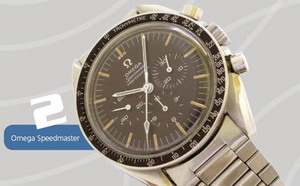
|
|
Stein:
My next choice will be a little
more conventional for vintage
collectors: an Omega Speedmaster
from around 1968. The Speedmaster
is the consensus "icon", the
chronograph most collectors would
have if they can only have one.
I'll save a few dollars, by going
with the 861 movement, rather
than the fabled (and more
expensive) 321 movement. I'm
confident that we will be able to
find a nice sample, on a
bracelet, in the $1,400
range.
|
|
|
IW:
So you have a Heuer and an Omega. What
will you have batting third in your
line-up?
|
|
Stein:
Next up will be the Sinn 156. In terms the
brands in my collection, Sinn is currently
my second favorite, and the 156 is one of
the stars of their line-up. The Sinn 156
uses the same huge case and rotating bezel
as the Heuer Bundeswehr chronograph, but
the Sinn is powered by the Lemania 5100
movement (rather than Heuer's Valjoux
230). This is a rugged watch; the minute
hand of the chrono is mounted on the
center pinion, and the chronograph is very
easy to read. This model has day/date, so
I'll wear this one when I think that will
be useful.
Since this may
end up as my daily wearer, I'll choose one
in average to good condition. The budget
for this piece can be set at around
$1,200.
|
|
IW:
So you have made your first three
selections, and you have spent only
$4,600. Let me guess that you have been
saving your money for something big. Tell
us about watch number four.
|
|
Stein:
Yes, the 861-powered Speedmaster and Sinn
156 have allowed us to save a few dollars,
and watch number four will use up even
more than we have saved. We'll be going
with a manual-wind Breitling Cosmonaute.
We're going to spend around $2,400 for
this one. With this budget, we won't be
able to afford the early black-on-black
version or the nicest of the later ones,
but this should be a good budget for a
nice sample, on a leather strap. We'll
save a few more dollars by choosing the
leather strap, rather than the bracelet;
I'm fine with this, as most of the 1960's
era Breitlings were shipped with the
leather
strap.
|
The
Cosmonaute has a true 24-hour
indication, and is powered by the
Venus 178 movement. I enjoy
24-hour chronographs and I'm into
the history of the early U. S.
space flights, so this Cosmonaute
addresses two items on my
wish-list. The Cosmonaute was the
first chronograph worn in space,
in May 1962.
|
|

|
|
|
|
IW:
Well, we may have a bit of tough news for
you now. You have picked four watches that
cost a total of $7,000, so you have only
$1,000 remaining. Tell us what you are
going to choose with these remaining
dollars.
|
|
|
|
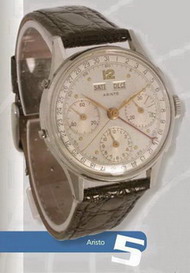
|
Stein:
Actually, this is one of the
easier choices and shows one of
my favorite strategies. I'm a
real enthusiast of what we call
the "poor man's Heuers" --
watches manufactured by Heuer,
but sold under other brand names.
So my fifth chronograph will be
an Aristo, triple calendar, three
register chronograph, from the
1950's.
If
this were a Heuer, we would pay
$2,500 to $3,000 for a top-rated
sample. With the Aristo name on
the dial, we will get the same
look for around $1,000. We also
get the same movement, the
legendary Valjoux 72c. If we
can't find this Aristo
day-date-month chronograph, then
we can keep our eyes open for
other "poor man's" versions, made
by Heuer for Zodiac or Clebar.
Any of these will give us the
look and feel of the Heuer, at a
small fraction of the
price.
|
|
|
|
IW:
So you have made you five selections, and
spent the full $8,000. How would you
summarize this collection?
|
|
Stein:
I have five chronographs, from five
brands, with five entirely different
movements -- Valjoux 72c, Venus 178 ,
Lemania 5100, Omega 861, and the Cal 14. I
have a good representation of the
different complications -- GMT on the
Autavia; day-date on the Sinn; and
day-date-month on the Aristo -- and we
have spanned a 30-year period, from start
to finish. Three are on bracelets; two on
straps. I could be very happy wearing
these five for the next five
years.
|
|
IW:
Now let's hit you with some additional
questions, to force you to change the mix
of watches in your collection. We'll start
with some good news: We have found an
additional $1,000, so you can upgrade or
swap out one of your watches. What will
you do with the extra
$1,000?
|
|
Stein:
That's some good news, Let's see how we
can spend that money. I'm 100 percent
happy with the Autavia, the Sinn 156 and
the Aristo triple-calendar. So there are
two possible upgrades: we can upgrade the
Speedmaster from the 861 movement to the
321 movement, or we can upgrade the
Breitling Cosmonaute, to the earlier
black-on-black dial. If we get really
lucky, we can add an original bracelet.
Either the 321 Speedie or the early
Cosmonaute would be the "trophy" piece of
this collection; if forced to choose one,
I would spend $3,400 on a black-on-black
Cosmonaute.
|
|
IW:
Now let's go the other direction. Times
are bad, and we need to prune $1,000 from
your original budget. How do you save
$1,000 from these initial
choices?
|
|
Stein:
That's
actually easier, and less
painful, than you might imagine.
Once again, we'll ship out the
$2,400 Breitling Cosmonaute, and
this time we will trade down to a
$1,400 chronograph. We can find a
nice "non-icon" chronograph for
$1,400. My top choice would be a
three-register Abercrombie &
Fitch from the early 1950s, made
by Heuer and powered by the
Valjoux 71. So you are getting
the idea. I like the Cosmonaute a
lot, but it's using up a lot of
the budget, so whether we want to
upgrade the collection with a
trophy or save some money, the
Cosmonaute will be the one I am
most likely to switch
out.
|
|

|
|
|
|
IW:
Looking back at your original five
selections, is there anything that might
be called a glaring omission? Any regrets
that you might want to address, for
example, if you were allowed to choose a
sixth chronograph?
|
|
Stein:
Looking at my original five chronographs,
and seeing the choices from Heuer, Omega,
Sinn and Breitling, some chronograph
collectors would suggest that the missing
brand is Zenith, and that the logical
extension of the collection would be with
the addition of an El Primero. If you will
increase the budget, we can add an El
Primero anywhere in the $1,400 to $4,000
range. I would probably keep it simple,
and go with one of the smaller, earlier El
Primeros, from around 1970. We could do
that, with an extra $1,500 to
$1,800.
With Heuer,
Omega, Breitling and Zenith in the
line-up, no one could say that we have
missed any of the "major" brands of
vintage chronographs, at least the Swiss
ones. Seiko collectors will remind us that
for an additional $200 to $400, we can add
one of their colorful
chronographs.
|
|
IW:
Is there anything else "missing" from this
collection? The same way that Zenith was
the missing brand from your original five
watches, is there anything missing, in
terms of features or complications, or any
era or "look" missing from this
collection?
|
|
Stein:
Looking back over the list, the missing
watch might be a more conventional dress
watch. There is always the question,
"Which one would you wear with a tuxedo?"
I would be happy wearing the Aristo as my
dressy watch, but some would say that any
chronograph is a "tool watch" and would
look funny under French
cuffs.
Being a "chrono
guy" who only wears a tuxedo a couple of
times per year, I wouldn't want to spend
too much on this dress watch. If you told
me that I had to have one non-chronograph,
I would probably add an Omega from the
1950s, maybe a Constellation or
Seamaster.
|
|
IW:
OK, now we are going to ask some
rapid-fire questions, and get some quick
answers. Here's the first one. Your
original five are all black and white
(except for the red and blue bezel on the
Autavia). Make a change to give us some
color!
|
|
Stein:
The easiest way to give the collection
some color will be to drop the Sinn (our
rugged, every-day watch), and bring in a
bright divers watch -- probably a 1970's
piece from either Doxa or Favre-Leuba. The
Gallet Excel-O-Graph would give us red,
white and blue, and a slide rule, for
around $1,000 To add color further up the
food chain, I'll drop the black and white
Cosmonaute (at $2,400) and add a big, blue
Zenith or Movado El
Primero.
|
|
IW:
As a variation, now we'll mandate that you
must spend at least half of your $8,000
original budget on one watch. Tell us
about your $4,000 "trophy" watch, and also
about the remaining four, that you would
buy with a limit of $4,000?
|
|
Stein:
With $4,000 to $5,000, I would buy one of
my three "grail" watches: a "Steve
McQueen" Monaco from Heuer (which may end
up at $5,000), a three-register Heuer
Carrera, silver dial with black registers
(at around $4,000) or a Lemania 5100
powered Speedmaster, in the 1960's style
case. In terms of the other watches in the
collection, I will drop down to "beater"
versions of the 861 Speedmaster and Sinn
156 (at $800 to $1,000 each) and prowl the
flea markets for two $500
watches.
|
|
IW:
Now let's go the other direction. You''ve
told us about your $4,000 or $5,000
"grail" watches, and you've told us about
the dressy one that you'll wear with a
tuxedo, Which of your five chronographs
will you wear to go running or to mow the
grass?
|
|
Stein:
I would be happy with the Sinn 156 as the
rough-and tumble chronograph of the group.
This one can be the "beater" of the group,
especially if I were able to return it to
you at the end of five years. If I
couldn't stand to do this to the Sinn, the
best choice would be to buy a "beater" at
the outset. I'm confident that with a
budget of $400, I can find a rugged three
register chronograph, that will be perfect
for mowing the grass or timing the morning
run. Several manufacturers produced solid
chronographs, powered by the Valjoux 7750
and in an indestructible "sewer
plate"-style steel case.
|
|
IW:
That's been a whirlwind tour of your
fantasy collection, but now let's go back
to the friend that you mentioned in
response to our first question: How has
your friend done with his "5-4-8"
collection?
|
|
Stein:
He has
bought three watches and he's enjoying
them every day. He's got a mint 861
Speedmaster, a blue /gray El Primero, and
an automatic Carrera, from the early
1970's. So he's loving his first three
chronographs, and the best news of all is
that he's still got $3,000 remaining for
the last two!!
|
|
|
|
|
Acknowledgments
and Photographs
|
The
question posed in this article -- "Which
five watches would you buy with a budget
of $8,000?" -- began with a discussion at
the office "water cooler", then progressed
to an internet discussion forum for
vintage Heuer watches -- the
Chronocentric
Vintage Heuer Discussion
Forum
-- and now is captured by the article in
International Watch. Many thanks to all
those who expressed their views during
these discussions.
Following
are high-resolution photographs of the
chronographs that appear in the article.
Thanks to David Devos and Ralf Beinenz for
their contribution of these excellent
photos, as well as their insights into
collecting vintage watches.
Special
thanks to the crew at International Watch
-- Gary, Michael, Jon and Phillip -- for
making the decision to run this series and
for allowing me to be the first "featured
collector". This was good fun, and I look
forward to working with you guys to
develop the series further.
|

|
|
Heuer
Autavia GMT, photo by Ralf
Beinenz
|
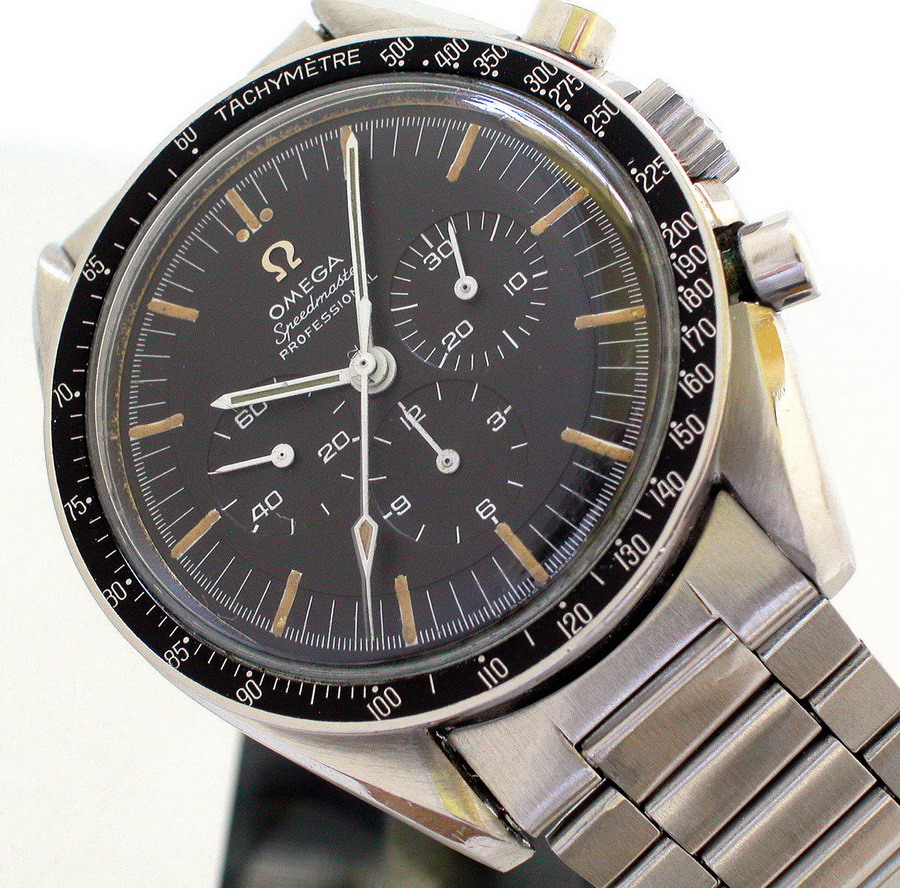
|
|
Omega
Speeedmaster, photo by David
Devos
|
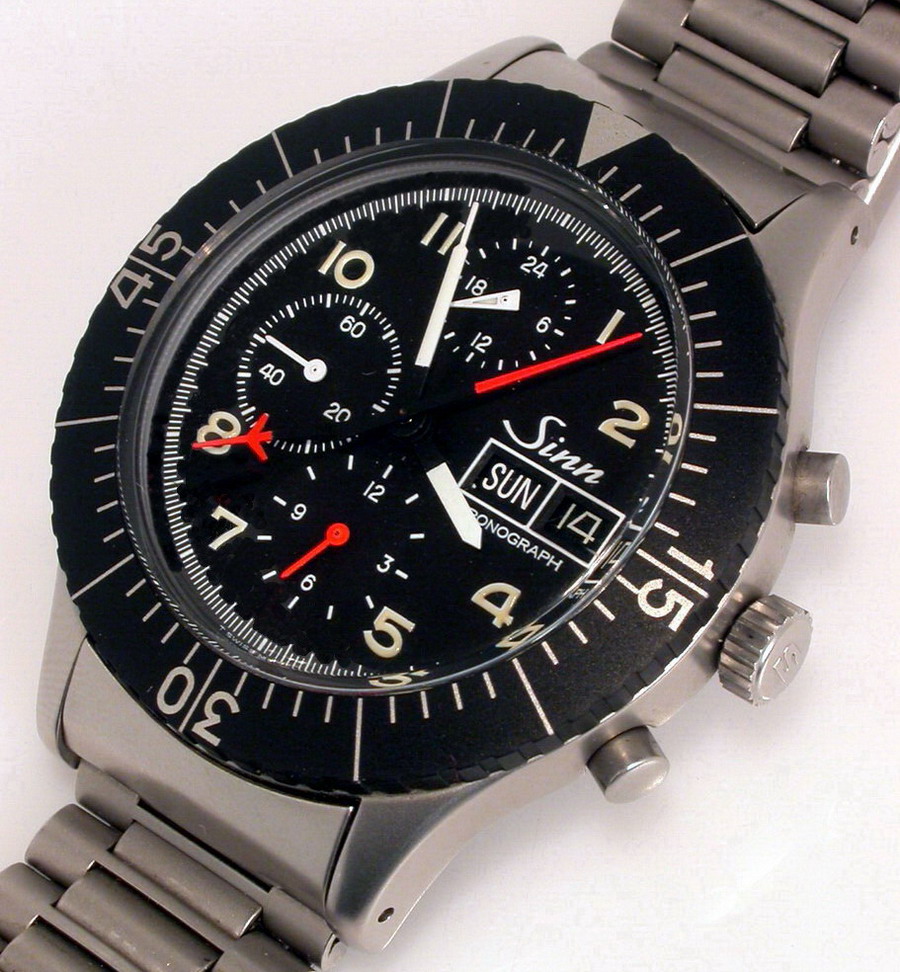
|
|
Sinn
156, photo by Jeff
Stein
|
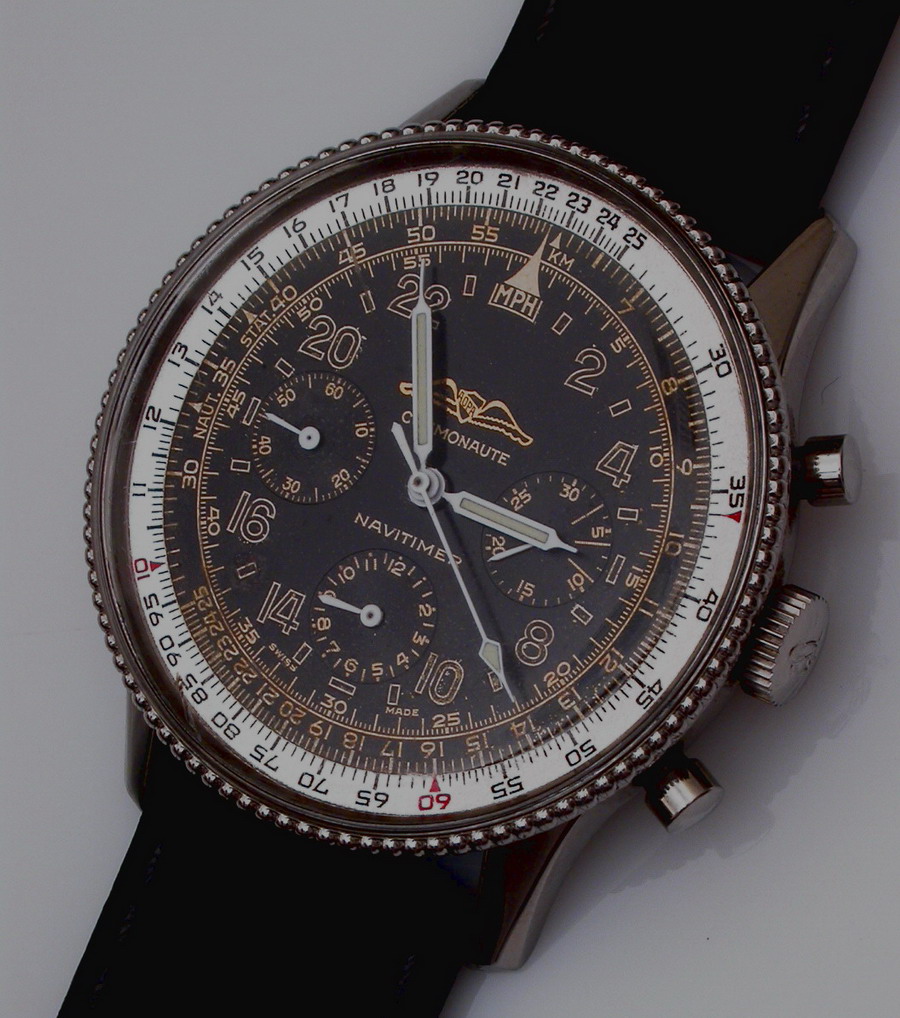
|
|
Breitling
Cosmonaute, photo by Jeff
Stein
|

|
|
Aristo
Triple Calendar Chronograph, photo by Jeff
Stein
|

|
|
Abercrombie
& Fitch Chronograph, photo by Jeff
Stein
|

|
|
Zenith
El Primero, photo by David
Devos
|

|
|
Movado
El Primero, photo by David
Devos
|

|
|
Gallet
Excel-O-Graph, Photo by Jeff
Stein
|

|
|
Zenith
El Primero, photo by David
Devos
|
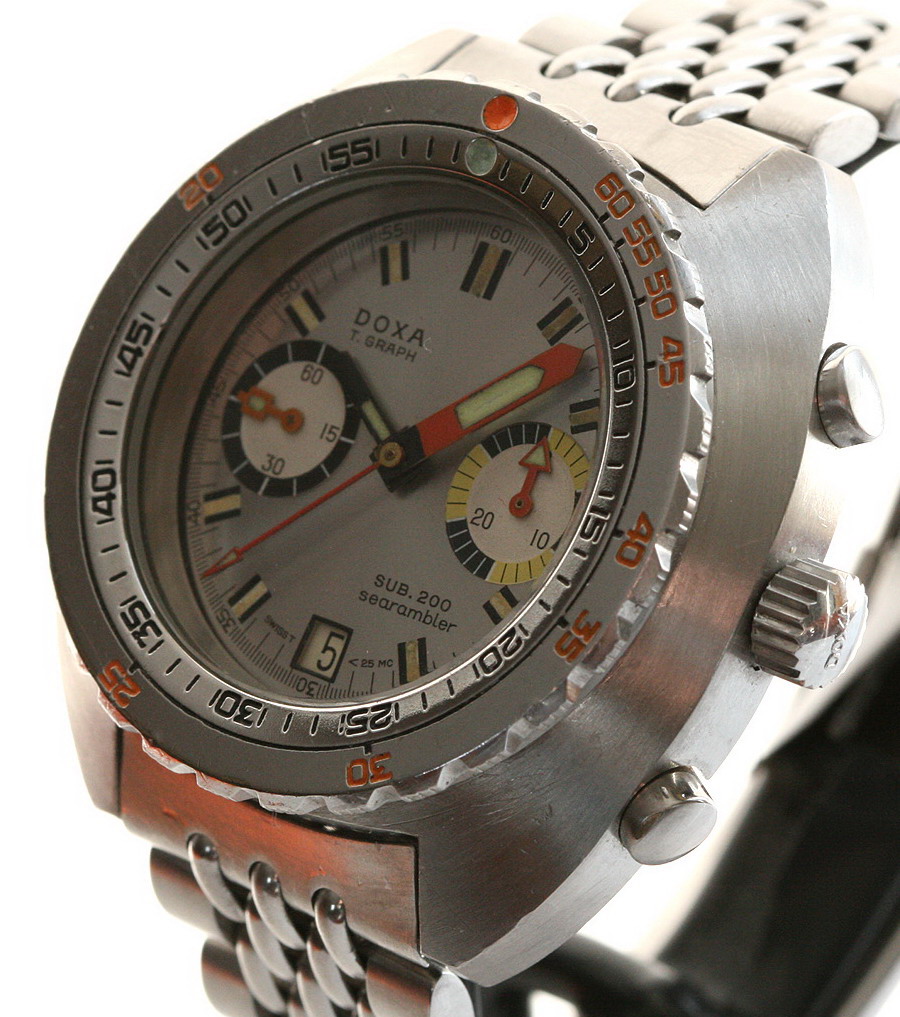
|
|
Doxa
Searambler, photo by David
Devos
|

|
|
Heuer
Carrera 12 Dato, photo by David
Devos
|

|
|
Omega
Speedmaster 5100, photo by David
Devos
|

|
|
Heuer
Monaco ("Steve McQueen" Version), photo by
Ralf Beinenz
|

|
|
Photograph
by Harold Alan Photographers, Atlanta,
GA
|
|
|
|
|
|
|































